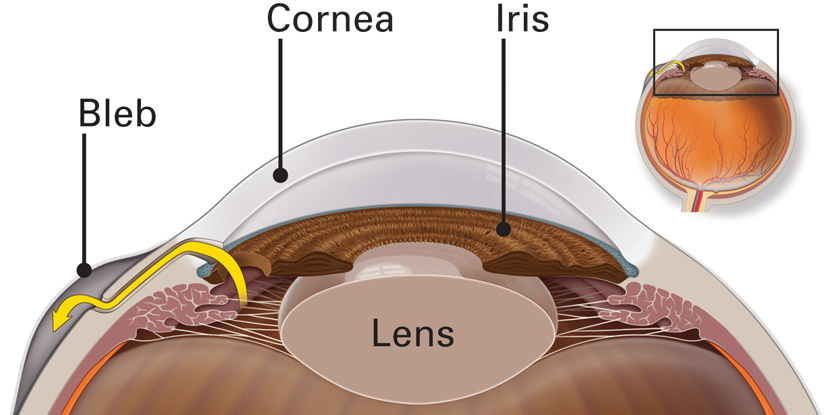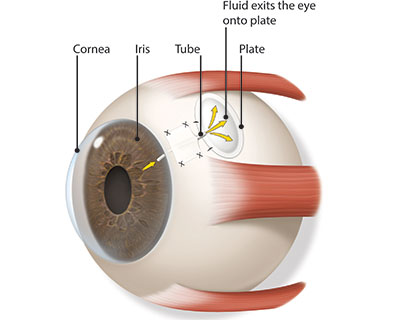Combined Cataract-Glaucoma Surgery and MIGS
Treating glaucoma and cataract at the same time
Cataracts (when the eye's naturally clear lens becomes cloudy with age) and glaucoma (when eye pressure inside the eye rises and damages the optic nerve) are two of the most common eye diseases in the world. Both diseases are more common in people as they get older. Many people with cataracts also have glaucoma. If a cataract makes it harder to see clearly, and eye pressure is not as it should be despite medicine or laser treatment, your doctor may suggest treating both at the same time.
Cataract surgery and MIGS
There are now several newer glaucoma procedures that do not require as much cutting into the eye and may involve less risk than traditional glaucoma surgeries (trabeculectomy and tube shunts). These are called MIGS, or micro-invasive or minimally invasive glaucoma surgeries. Many of these surgeries can be combined with cataract surgery for people with mild to moderate open-angle glaucoma. And most of them use the same incision, or small cut, to enter the eye that your surgeon uses to remove the cataract. Most MIGS surgeries move the trapped fluid from the eye by removing the blockage or bypassing it with a small tube or stent. These surgeries help lower eye pressure and may enable you to stop some medications. But they may not lower it enough to stop all glaucoma medications.
Here are some reasons your ophthalmologist may recommend a MIGS at the time of cataract surgery:
- to lower eye pressure. Even if your pressure is low, MIGS may provide better pressure control now and in the future.
- to take fewer medications. If the glaucoma surgery is successful, you may be able to decrease or even stop taking glaucoma medications. Many people find it hard to use eye drops.
When to have combined cataract surgery and glaucoma surgery
To find out what treatment is right for you, your ophthalmologist will examine your eyes. They will consider:
- your current glaucoma treatment and if it lowers your eye pressure enough
- whether you are tolerating the side effects and expense of your glaucoma medications, and
- whether your cataracts keep you from doing your daily activities
Your ophthalmologist will suggest a treatment that gives you the best chance for better vision with the least amount of risk.
If doing glaucoma surgery and cataract surgery is right for you, your ophthalmologist then will choose which type of combined surgery to do.
Cataract surgery and trabeculectomy
For those with more severe or poorly controlled glaucoma, having a trabeculectomy with cataract surgery may lead to lower eye pressure. Your ophthalmologist removes your eye’s cloudy lens and replaces it with an artificial one. During the trabeculectomy, your surgeon creates a tiny opening, or flap, in the white of your eye. Then a bubble-like pocket, called a bleb, is also created over the white of the eye. The excess fluid drains out of the eye through the flap and into the bleb. The fluid in the bleb is absorbed naturally by the body, lowering eye pressure.

Cataract surgery and glaucoma shunt procedures
During this surgery, your ophthalmologist will remove your eye’s cloudy lens and replace it with an artificial one. To help lower your eye pressure, they will also put a tiny, plastic tube called a shunt under the thin, clear membrane covering the white of your eye. The shunt sends blocked fluid inside the eye to a small, plastic plate your surgeon puts on the eye wall. There, the fluid is absorbed by blood vessels nearby. This helps lower eye pressure.

Here are some reasons why your ophthalmologist may suggest combined surgery:
- It is easier for you: One visit to the operating room is more convenient and less stressful than two surgeries.
- Less risk: Risks with anesthesia are cut in half since you only have to have anesthesia once.
- Keeping eye pressure stable after surgery: After cataract surgery, sometimes eye pressure rises suddenly. With the addition of glaucoma surgery, this rise in eye pressure usually does not happen.
- Lower cost: Having two surgeries at one time is less expensive. And if the glaucoma surgery is successful, you save money by not needing as much or any glaucoma medicine.
Combined cataract and glaucoma surgery is not for everyone:
- Sometimes a cataract is not causing vision problems, but the glaucoma needs to be treated. In these cases, it is best to do the glaucoma surgery and delay cataract surgery until later.
- In other cases, glaucoma is well-controlled without surgery, but cataracts are limiting vision. In these cases, cataract surgery alone or cataract surgery with MIGS may be the best option.
- Other patients have cataracts and a kind of glaucoma called narrow- or closed-angle glaucoma. With this type of glaucoma, the iris (colored part of your eye) is pushed too far forward, blocking fluid from leaving the eye. This raises eye pressure. A cataract can make this type of glaucoma worse. With the cataract removed, eye pressure may improve without glaucoma surgery.